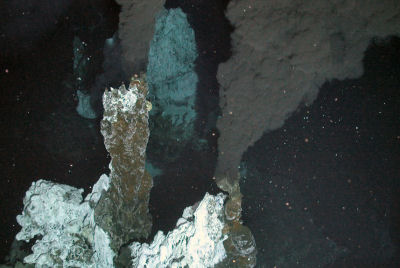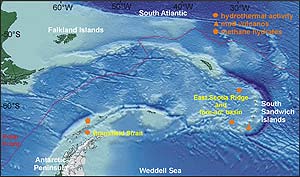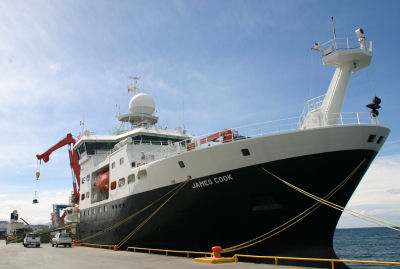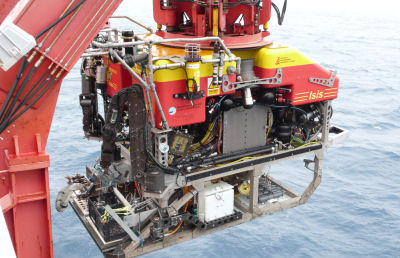Friday 14th January
Today's contributor: Jon Copley
Early this morning we left our berth at the container port outside Punta Arenas in southern Chile, to begin Voyage 55 of the Royal Research Ship James Cook. Over the next six weeks we'll be investigating volcanic vents on the ocean floor around Antarctica, in the final expedition of a three-year programme of exploration.
Deep-sea vents are home to lush colonies of life on the ocean floor that are linked by the flow of their inhabitants' offspring between them. But exactly how this web of life works, and how it has worked in the past, is not known. Understanding this is vital if we are to use the deep ocean responsibly in the future - as well as important for finding out more about how our world works.

Life at vents around Antarctica could be related to that known in the Pacific, thanks to deep-water currents that run from west to east through the Drake Passage between Antarctica and South America. Alternatively, life at vents around Antarctica could be related that found on the Mid-Atlantic Ridge via 'stepping stones' that existed in the geological past.
A third possibility is that life in these habitats around Antarctica could be completely different, having evolved in isolation. So exploring the marine life at deep-sea vents around Antarctica can show us what's behind the patterns of life in the deep ocean, which is the largest environment on our planet. The International Census of Marine Life therefore identified deep-sea vents around Antarctica as a priority for investigation - and that's what we're here to do.

We'll be using the remotely operated vehicle Isis, which can dive to 6000 metres deep, to map the ocean floor, reveal its landscape and inhabitants, and collect samples for analysis. Weather and ice permitting, our itinerary will take us first to the Bransfield Strait on the Antarctic Peninsula, to explore deep-sea vents that have been detected - but not yet seen - in that area.
After working in the Bransfield Strait, we plan to head to the South Sandwich Islands, where our expedition in 2009 discovered a crater on the seafloor, two-and-a-half miles across and a mile deep, containing deep-sea vents unlike any we have seen before. Time allowing, we may also stop at yet more deep-sea vents on a chain of undersea volcanoes called the East Scotia Ridge, which we explored with the Isis ROV last year.

Aboard the ship, we have a team of scientists who will examine the links between colonies of creatures at different sites, study the environmental conditions and microbes at the different vents, investigate how energy flows through their food webs - and much more. Our team comes from several universities and institutes in the UK and US (please see the 'Team' pages for further details), led by Prof Paul Tyler, a deep-sea biologist from the University of Southampton. And our science is only possible with the support of the engineering team who operate the Isis ROV and other scientific equipment, and the ship's company who run the vessel and look after us.

Through these pages, we'll be sharing news of the science that we're doing, the technology that we're using, and what it's like to live and work aboard a research ship in the Antarctic. We hope you'll be able to follow our journey as we reveal this part of our world and its inhabitants for the first time.
Our departure into the Straits of Magellan towards the open ocean was slightly delayed today while we waited at anchor for a delivery of fresh stores, following a regional strike that cut off roads into Punta Arenas. But with the stores aboard, and our final clearances, we're now under way.
January 2011
| Mo | Tu | We | Th | Fr | Sa | Su |
| 1 | 2 | |||||
| 3 | 4 | 5 | 6 | 7 | 8 | 9 |
| 10 | 11 | 12 | 13 | 14 | 15 | 16 |
| 17 | 18 | 19 | 20 | 21 | 22 | 23 |
| 24 | 25 | 26 | 27 | 28 | 29 | 30 |
| 31 |
February 2011
| Mo | Tu | We | Th | Fr | Sa | Su |
| 1 | 2 | 3 | 4 | 5 | 6 | |
| 7 | 8 | 9 | 10 | 11 | 12 | 13 |
| 14 | 15 | 16 | 17 | 18 | 19 | 20 |
| 21 | 22 | 23 | 24 | 25 | 26 | 27 |
| 28 |
